
INSTANT FENCE!
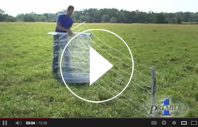
ElectroNet®
Electric Netting
This is our go-to net for fencing sheep and rotational grazing. It's difficult to imagine grazing animals without it. Fits any pasture. Keeps in sheep, goats and guard dogs while keeping out stray dogs and coyotes.
ElectroNet is a prefabricated fence that has 9 horizontal twines (8 conductive); is 35" tall installed, and has large white plastic vertical struts every 12". White PVC posts are built into the mesh every 12.5 ft. The result, when energized properly, is a nearly impenetrable mesh to sheep, goats, coyotes and dogs.
The black and white colors provide 24/7 visibility to both humans and animals against light and dark backgrounds. Its low electrical resistance (only 38 Ω/1000 ft) is an important benefit for longer fences and/or fences with high weed contact.
Is your net sagging? Try our ElectroNet Plus. Posts every
6.8 ft (vs 12.5 ft for standard ElectroNet). More posts means less sag and a more versatile fence.
PREMIER PICK
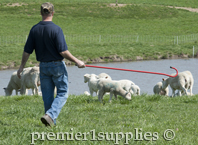
RedCote™ Crook
Want to make your pasture-lambing season a little easier? Crooks are an essential item when it comes to handling livestock. A well-handled crook can reduce the time and effort it takes to move/work the flock.
Lightweight and maneuverable, the RedCote™ works well for catching lambs and moving/herding sheep. Crooks made of uncoated aluminum tend to leave black residue on your hands and clothes. RedCote crooks don’t.
Outer red plastic finish on aluminum tube means it’s easy to see, and thus less likely to be lost in grass, straw, hay or barn closets. Black rubber handle and tips. Lowest-cost neck crook.
View all of
Premier's Lambing Supplies.
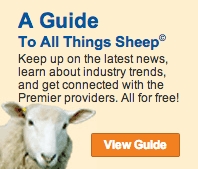
|
 |
 |
MESSAGE FROM THE OWNER
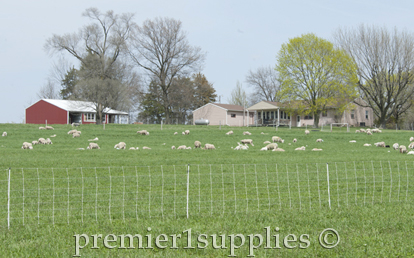
A follow-up report about
Premier's new lambing system
By Stan Potratz
I introduced the system in our February newsletter—by which time 250 ewes had passed through the system. That number has now increased to 650 ewes. As I noted in the earlier newsletter, the fundamental change we made from all of our previous indoor-lambing methods has been to put the ewes into jugs just prior to lambing instead of first allowing them to lamb in a drop pen and then attempting to pen ewes with their lambs for 1 to 4 days.
Results to date:
| • |
Of the first 600 adult ewes through this system, 14% had singles, 57% had twins, 26% had triplets and 1.5% had quads. |
| |
Of the 1275 lambs that came out of these ewes, 4% were born dead (abortion, premature, dystocia). Another 3% died within 3 days (often because they were too small to compete). |
| • |
1186 lambs were alive after 3 days.
|
| • |
Number of ewes assisted by human shepherds to lamb? Less than 8%.
|
| • |
Number of orphan lambs? 50 (3%)
|
| • |
Number we assisted to nurse or tubed? 25 (2%)
|
| • |
Disease outbreaks in either ewes or lambs? None
|
| • |
More dystocia and thus the need to assist when rams were larger breeds.
|
| • |
A percentage of ewes for a 4-week period had unusually small lambs—due, we conclude, to feeding them lower quality soybean/millet baleage in the 5 weeks prior to lambing. We switched to better baleage and lambs have returned to normal size at birth.
|
Discussion:
We particularly prefer jugging before lambing vs lambing in a drop pens for ewe lambs and ewes with Romanov genetics in them. Why?
| 1. |
Both sub-groups are excitable and have large flight zones. Therefore, it's often difficult to get both the ewe and her lambs into a jug immediately after they have lambed—and efforts to do so appeared to increase the lamb abandonment risks |
| 2. |
They are prolific ewes. Drop-pen lamb mismothering (lamb rejection, lamb abandonment) appears to increase exponentially as the number of lambs dropped per ewe increases. To discover that 4 half-Romanov ewes have lambed 14 lambs into a drop pen of 20 ewes during the night is not an experience that a bleary-eyed shepherd wants at 6 a.m. Lambs and upset ewes are everywhere. Confusion and frustration is the operative word. |
How often do we check our ewes that lamb in jugs? 5 times during the daylight. Not at all during the night.
How many ewes lamb per day? 15 ewes had 36 lambs last Saturday. That was a record. The average is more like 8 ewes.
Has it reduced the human lambing hours/minutes required to produce a viable lamb?
| • |
It took much less time to jug ewes prior to lambing (obviously) than after lambing. |
| • |
It absolutely eliminates time spent sorting out mismothering puzzles and consequent lamb abandonment. |
| • |
It requires more time to feed, water and bed 60 single-ewe pens each day than to do the same for 2 pens of 30 ewes each. (We will automate some of these processes next year.)
|
Culling? Unlike pasture lambing, shed lambing allows us to clearly see which ewes and their lambs needed to be culled and why—and which ewes were the prolific, minimal-care mothers.
Overall, is it more work per ewe than pasture lambing? The extra feeding and bedding requires more work per ewe. But the work is all daytime work. And we paid for that labor because we saved 180 extra lambs (from 600 ewes). It was certainly more pleasant to have many fewer dead lambs than we would have had with pasture lambing this year, which normally would have begun here 2 weeks ago. Consider that the past 2 weeks have seen 8 days of cold wind, below 40-degree temperatures and frequent rain, mist and fog. Past experience tells us that 150 of the 450 lambs that would normally appear within this 2-week period with 2013 weather conditions would be dead.
Lamb growth after lambing? We've been very surprised at the success we've had rearing shed-lambed triplets on ewes indoors. Our "triplet" ewes have lib access to clover/grass baleage and soy hulls. Triplet lambs have access to creep feed. We wean them at 8 to 10 weeks. Twin ewes have access to baleage and lambs have access to creep feed. Single ewes have baleage only.
Ewes born after March 10 go to pasture with their lambs. We now have 250 ewes on pasture (those with twins and singles born after March 15). All ewes with twins and singles born before March 15 are being weaned today, because the lambs are nearly 8 weeks old. Ewes with triplets have access to pasture and ad lib soy hulls.
Conclusions? If you have less than 20 ewes, this system isn't that useful for you. Mismothering won't be a major concern for you, because it's not likely that 2 ewes will lamb in the same 8-hour period. But if you have more than 50 prolific ewes (likely to produce more triplets than singles), this system is worth considering, particularly if you need to work away from home during the day and sleep during the night.
Ewe lambs for sale
Premier will have 400 ewe lambs for sale this summer. Out of Dorper/Romanov/Katahdin ewes and Dorper/Romanov sires. Available June/July at 70–100 lbs live weight. First come first serve. Priced at 50% above prevailing market price for slaughter lambs of this type. If you are interested, email spotratz@premier1supplies.com.
POISONOUS PLANTS & TREES
What's growing in your pasture?
Before grazing your flocks on the pastures, take a walk-through and check for any potentially hazardous plants and trees. Finding and eliminating problem plant species before they are an issue will aid in making this year's grazing season more successful.
Common Poisonous Plants
By Roger High
OSU Extension Sheep Specialist and Director, Ohio Sheep Improvement Association (OSIA)
While most plants are beneficial, some are hazardous to animals and human life. Ohio has about 100 toxic plants and some of these are responsible for deaths of domestic livestock every year. The number of cases of toxicosis (plant poisoning) in livestock far outweighs those reported for humans. Accurate statistics are not available, but it is estimated that several thousand animals die annually in the U.S. from plant toxicosis. Read More »
Poisonous Trees
By Clif Little
OSU Extension Agriculture/Natural Resources, Guernsey & Noble Counties
Recent storms downed many trees throughout Ohio, and some of these pose a threat to livestock. Poisoning is most common when grazing is scarce, such as periods of dry weather coupled with thunderstorms that down trees during the mid to late summer months. Read More »
VIP ARTICLE
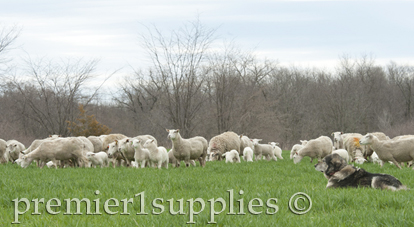
Managing pastures for sheep
By Susan Schoenian
Extension Sheep & Goat Specialist, University of Maryland
The pasture resource is often the most neglected part of the sheep enterprise, yet it usually provides the majority of nutrients to the stock.
Well-managed pastures that are properly grazed have the potential to minimize feed costs and increase profits. Pasture is the most natural diet for sheep and other ruminant animals. Though pasture is not without its own risks, fewer digestive problems are usually encountered among grazing sheep and lambs. Read More »
|
|